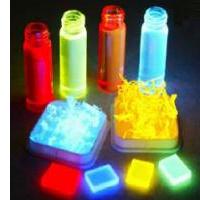
|
Polymers for electronic devicesThere are a number of significant research efforts in this area across the Polymer IRC. These include: Organic light emitting diodes
There is at present significant interest in the creation of displays based on polymer LEDs, as large area devices are relatively inexpensive to manufacture. They are also efficient and can have emission colours ranging from the near UV to the near infrared. Furthermore, as conjugated polymers are plastics, fully flexible LEDs can be created. To create a full-colour display it is necessary to define an array of pixels, emitting either red, green or blue light. However patterning different conjugated polymers on a surface at high resolution is not straightforward. The most promising approach explored is that of ink-jet printing. However the resolution of this technique is limited to ~ 50 µm, and it also requires that the expensive printing heads used in the manufacturing process are replaced at regular intervals. Other alternative polymer patterning processes, such as screen-printing consume large quantities of organic solvents, which are difficult to dispose of in an environmentally friendly manner. Very recently, we have developed a new route to pattern different conjugated polymers with very high resolution. In particular we have demonstrated the patterning of three different conjugated polymers on a surface into a series of stripes, with each stripe each having a width of 10 µm. At present, our principle interest has been the creation of light emitting devices and displays. However there are a number of other applications for our technology that we have not yet explored. In particular, our technology could be adapted to pattern purely electronic devices such as field effect transistors. This could present an attractive route to create cheap, lightweight electronic circuits and devices. Alternately, by using polymeric materials that 'harvest' light rather than emit light, we could create small, high-resolution arrays of photovoltaic devices. These could be used in miniature imaging systems. By taking advantage of the inherent flexibility and biocompatibility of polymeric devices, such photovoltaic arrays could be used as artificial retinas in eye-damaged patients. Materials development for application in displaysOrganic based light emitting displays OLEDs are an emerging flat-panel technology based on layers of organic materials forming a p-n junction that emits light when injected holes and electrons recombine. The organic materials are commonly either small molecules or conjugated polymers. Development of this technology has been prompted by the increasing need to satisfy the demands for low-cost, flexible and bright colour flat screen displays with low power consumption. Polyfluorenes are at the forefront of materials currently developed for application in this area. Interest in these materials originate from the fact that they have a wide bandgap and could be used both as blue emitters as well as hosts for lower bandgap materials for emission of light throughout the visible spectrum. We have recently developed and patented a new class of wide bandgap carbazole based conjugated polymers with high fluorescence quantum yields. These materials constitute rival materials to polyfluorenes for application in LEDs. An added advantage of this new class of materials is their lower ionisation potentials, which makes them highly attractive for use in flat panel light emitting displays. A future development of this theme will exploit the potential for rapid switching offered by block co-polymeric materials. Recent comprehensive studies at Leeds on a model BCP system showed how polystyrene cylinders could be oriented on cooling in a magnetic field. Radar active materials and smart microwave materialsThe military applications of radar active materials (RAM) and smart microwave materials and structures are self-evident. The applications we are working towards include tuneable antennae - without the need to physically change its shape! The materials we are synthesising are composites of ionic and electrical conductors, making use of the Ag/Ag+ or Cu/Cu2+ redox couples to ensure they are electrical insulators in their resting 'off' state. On applying a field from the edges of the polymer window, a redox cascade occurs resulting in greatly increased conductivity, and a corresponding reduction in microwave transmission through the film - by a factor of 20 for some polymer blends. Switching times are of the order of 0.25 s at field strengths of 4 V/cm. Movie (above right) shows the change in properties of smart microwave materials which can be switched between 'insulating' microwave transparent materials to 'conducting' microwave reflective materials at the flick of a switch. Move your mouse over the clip to (re)start the movie. Solid state battery electrolytesRecent work at Sheffield has demonstrated solvent-free polymer electrolytes with ambient conductivities ~ 10-3 S/cm which are of the order required for the successful operation at ambient of a lithium polymer battery. Unlike the well-known ‘conventional’ amorphous solvent-free systems having ambient conductivities ~10-5 S/cm the new Sheffield materials have a low-dimensional (layered) structure giving enhanced lithium ion mobilities. Conductivities at –5°C of ~10-4 S/cm are also observed. Current work is engaged in the further development of cathodes based upon particulate transition metal oxides and assembly into solid-state lithium batteries. This aspect of the work is being carried out in conjunction with Professor A. R. West of the University of Sheffield who is an international expert on metal oxide cathodic materials. Such batteries are expected to have the potential for high energy densities (~200 Wh/kg i.e. 7-8 times the capacity of a lead-acid cell) at ambient and subambient operation, at reduced pressures and devoid of the hazards associated with solvent-containing systems, particularly for heavy-duty applications (e.g. traction). In Leeds novel extrusion/lamination process has been devised (and patented by BTG) for making rechargeable lithium batteries directly by continuous extrusion of the polymer gel electrolyte. The spin-off company (GELECTRIX) set up to exploit the Leeds inventions is now in dormancy. It has been replaced by substantial BTG funding (£250K) to build a prototype production unit at Leeds and set up a Joint Venture with a US company (SPECTRAPOWER). The research and development work is now underway, with supervision being transferred from Ian Ward to Alison Voice. |
|
|
|
|
© The Polymer IRC 2004, design www.cookandkaye.co.uk /
Webmaster /
Disclaimer /
Privacy The IRC includes the University of Bradford, the University of Durham, the University of Leeds and the University of Sheffield. | |
